Analyze Better to Operate Best
Introduction
Primary objective of incorporating PRDC® was to provide consulting services to the power utilities and industries. Power System Consulting remains to be the core business of PRDC®. The consulting group has grown by leaps and bounds, and is known to be one of the largest of its class today. PRDC® is proud to have a strong team of highly qualified technocrats supported by seasoned panel of consultants with rich experience of over 40+ years in the industry.
Services encompass a wide spectrum of power system studies ranging from analysis of a nanosecond time frame phenomenon to forecasts for several years ahead. The clients include small industry to expansive national grid spanning thousands of nodes spread across several million square kilometers. The projects span from basic loss calculations to complex network proposition and market mechanism.
With diverse client base spread across India, PRDC® also covers international clients across many continents. The group handles hundreds of projects at a time in major sectors like state owned and private generation, transmission and distribution companies, industries like steel plants, aluminum plants, cement industries, petro-chemical industries etc. Most of the projects are carried out using indigenously developed power system analysis and simulation software – MiPower®. It is the flagship software product of PRDC® that is extensively used by thousands of users across the globe. Other standard software products are also used depending on the client’s preference.
Consultancy services include both utility or grid connected and industrial or commercial businesses. Consultancy services are offered in various simulation time frames from nanosecond / micro-second time frame for very-fast-front transients, fast-front transients, millisecond for slow-front transients, ferro-resonance simulation and seconds to minute time frame for transient stability, dynamic stability, sub-synchronous resonance and steady state operation conditions like load flow analysis, short circuit analysis, protection co-ordination, harmonic analysis and voltage stability.
World is moving towards sustainable energy. Solar and wind are two major renewable energy sources that is widely being adopted globally. PRDC® offers its services to the investors, developers, utility and regulatory authorities. Services include pre-feasibility, detailed technical feasibility of grid integration, development of grid code, strengthening of existing grid code, assess grid code compliance etc. PRDC® has done almost all the wind energy studies in India, Indonesia and Mongolia. Most of the solar energy studies in India and Fiji are also done by PRDC®. It is an honor to proudly proclaim that Wind Energy Grid Code of India is prepared by PRDC® and amendments were done to Indonesian grid code. PRDC® is also working on grid code for facilitating cross-country power flow in South Asian region.
PRDC® has developed models and offers consultancy services in demand forecasting (time series, econometric and partial end use modeling), reliability analysis, load research, cost to serve, business plan for utilities, energy auditing & accounting, ground / earth mat design, insulation co-ordination, design of NGRs and disturbance analysis etc. Having expert teams with research capabilities and cross functional experience in the power sector, PRDC® can undertake all types of power system simulations and offer effective and quality solutions to all the customers.
PRDC® does turnkey works involving detailed engineering, pre-feasibility, detailed technical feasibility, DPR (Detailed Project Report), DTS (Detailed Technical Specification) with BOQ, RFP preparation, vendor identification, tendering assistance, vendor evaluation, procurement management, project management, monitoring, quality assurance, verification and certification services. Owner’s engineering consulting and project management consulting are also offered.
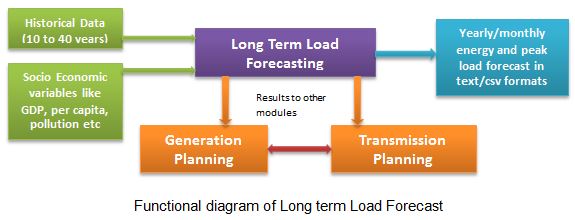
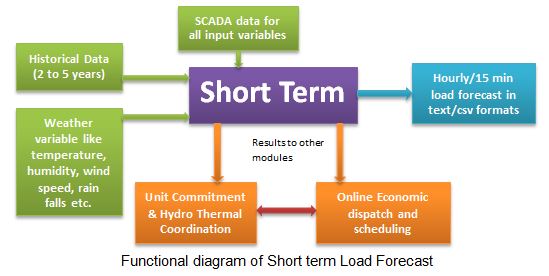 GENERATION PLANNING
GENERATION PLANNING
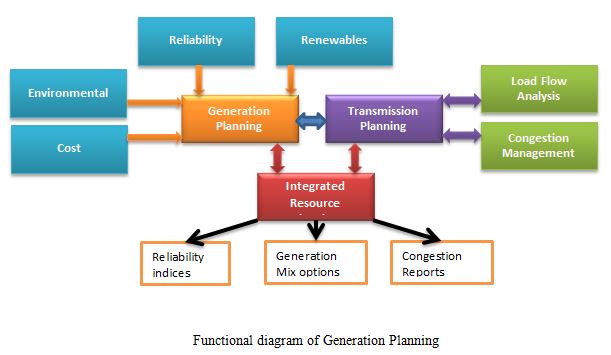 TRANSMISSION PLANNING
TRANSMISSION PLANNING
CONVENTIONAL GENERATION
Power evacuation and grid connectivity services cover design and analysis of evacuation schemes/alternatives for the generation projects considering relevant standards and grid codes. Based on the location and capacity of the generation plant, various schemes/alternatives would be analyzed to suggest the technically feasible grid connectivity scheme. With the extensive database of power system network available in PRDC®, the detailed model of system under study would be built for load flow, contingency analysis, short circuit and transient stability analysis. Based on several simulations spanning various operating conditions, performance of each of the considered options would be evaluated to understand the technical feasibility of each alternative. The cost analysis would also part of the analysis in determining the optimal and technically feasible options. The studies would also determine the reactive compensation requirement and insulation co-ordination.
Grid connectivity studies have been carried out for many private and state owned generating companies for checking the corridor availability to transfer power in both intra state and interstate transmission system. PRDC® also offers grid connectivity studies to check the feasibility of supplying power to their own consumers situated in different locations considering different options along with the comparison of open access rates considering both present and future network so that suitable decision can be made and feasible option can be discussed/finalized with utility for sending power to their consumer end.
RENEWABLE GENERATION
Wind and solar generation both experience intermittency, a combination of non-controllable variability and partial unpredictability and depend on resources that is location dependent. Hence grid connectivity and evacuation studies for renewable generations are necessary to assess the capability and reliability of the grid to evacuate the power from the wind or solar plants. Planning, operation and control of RE integrated power systems poses a variety of challenging problems such as the ability of the network to accommodate these generation, Voltage rise/drop, effect of these generations on fault levels etc. The solution of which requires extensive analysis of power systems integrated with renewable generations. Analysis comprises of load flow, contingency, short circuit, transient/dynamic stability analysis and also reliability analysis of the transmission system along with the proposed renewable generation. These analysis would be carried out considering relevant standards and grid codes. Optimization of internal wind farm network along with due-diligence of the proposed system is another area offered from us.
As an end to end solution, we also offer the micro-siting arrangement of individual wind turbines, internal wind farm design, engineering and project management of sub-station, transmission system and Balance of Plant. Our report provides clarity on power evacuation aspects to both investors and developers for taking suitable decision and is bankable document for the investment. We study the technical feasibility of wind/solar sites considering different evacuation schemes and our report acts as a support document for developers while approaching utility for the grid connectivity.
CONVENTIONAL SYSTEMS
To operate the system effectively with various stakeholders, it is essential to have procedures for planning, connection of various equipment’s in the grid and operation of the grid which will facilitate secure and optimum power system operation. Grid codes are the rules laid by the authorities for all its stakeholders, i.e., the users and power generating stations for connecting to the network and operate as per the standards. The grid codes mandates regulations and standard to be followed for connecting important power system components like new generators, transmission lines, protection system etc.
Based on the grid code regulation, we at PRDC® provide detailed studies and analysis to check the connected components whether they are grid compliant or not. We also provide assistance for making/changing grid codes in planning, connection, operation, protection, metering, scheduling dispatch and marketing guidelines. We have provided the services like making grid code for various countries like India, Indonesia, Fiji and also for grid code for cross border trading between countries or between regions.
RENEWABLE ENERGY
To operate the system effectively, a large number of components, such as protection systems, monitoring systems, operational procedures, etc. are required to work in a synchronized and efficient manner; otherwise, contingencies may arise in the system. Recent trend of penetration of the renewable energy sources to the grid has further enhanced the complexity of the network. Due to their stochastic nature, their integration has added more uncertainty to the grid, leading to increased concerns related to the accurate prediction of generation and control of power flow. In addition, the deregulation (privatisation and liberalisation) in the electricity sector have invited more generation and supplier entities to meet up the ever-growing demand of electricity. This addition of the new generation schemes along with a large number of competitors has led to following new challenges for the proper planning and operation of the present and future power systems: Increased level of complexity, Stochastic nature of power transfer capabilities and Bidirectional power flow across the system.
To safeguard, the electric power systems, against failures and address the issues raised, rules and regulations are required. These rules act as standard procedures and requirements for including or prohibiting connection of the generation plants and loads to the grid. The rules should be applicable to the both, new and existing, generation plants and users, who are interested to connect to the grid. Grid codes are attempts in this direction to ensure supply quality for the consumers. PRDC® has provided services to make grid codes for renewable energy sources which helped the utilities by providing grid integration procedures for connectivity and operation to accommodate the renewable in grid.
The planning, design and operation of industrial and commercial power systems require various studies to evaluate current and future performance, reliability, safety, risk and scalability.
Common studies include:- Load Flow Studies
- Short-Circuit Studies
- Relay Coordination Studies
- Motor Starting Studies
- Grid Islanding and Load Shedding
- Harmonics
- Fast Bus Transfer Study
- Stability Studies
- Energy Audit and Loss Reduction Studies
- Arc Flash and Safety Studies
- Reliability and Contingency Analysis
- Economic and Financial Feasibility Studies
- Detail Engineering and Tendering Support
- Digital and Scada Integration Studies
- Safety Audit and Compliance Studies
Power System Analysis is crucial for ensuring personnel and equipment safety, optimizing system performance, minimizing downtime and maintenance costs and meeting regulatory standards. By identifying and addressing potential issues, these studies help maintain safe and reliable power system operations.
Specialized studies like Fast Bus Transfer and EMTP (Electromagnetic Transients Program) are also conducted when needed.
At PRDC®, we have successfully conducted power system studies for a wide range of industries including steel, cement, aluminium, ferroalloy and process engineering plants — across India and internationally.
PROJECTS
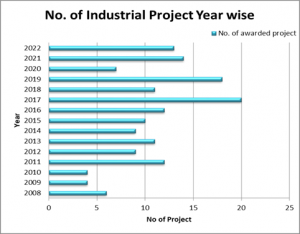 |
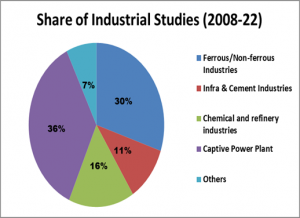 |
With decades of experience and a team of seasoned professionals, PRDC offers tailored industrial studies solutions to optimize power systems, reduce costs, and improve overall performance. By leveraging cutting-edge technologies and in-depth industry knowledge, we help clients achieve sustainable and efficient operations.
Choose PRDC as your partner for comprehensive industrial studies, and let us help you drive operational excellence and resilience in your power systems.
Load flow studies are essential for understanding how power flows through a system, from sources to various loads. They help determine Voltage, Current, Power, Reactive Power and Power Factor at every point in the system.
These studies are crucial before making any changes to the system and help identify the best operating configuration while also estimating system losses.
Operational issues can arise from:
- Changes in motors or their ratings.
- Modifications to transformer size or impedance.
- Unplanned operating configurations.
- Addition or removal of power factor correction capacitors or loads.
Load flow studies help assess such changes and recommend suitable configurations and connectivity options.
Signs that indicate the need for a load flow study include:
- Unbalanced or abnormal voltage levels.
- Motors failing to reach full load or tripping when other loads start.
- Excessive voltage drops.
- Poor power factor.
- Overloaded transformers or circuits, especially during contingency conditions.
For more detailed guidelines, refer to ANSI/IEEE 399 – Recommended Practice for Industrial and Commercial Power Systems Analysis (IEEE Brown Book).
Short circuits, or fault currents, release large amounts of destructive energy into electrical systems during abnormal conditions. While electrical energy is safely controlled during normal operation, However faults can lead to severe equipment damage and pose serious risks to personnel. In some cases, short-circuit currents can reach several hundred thousand amperes.
The main goal of a short circuit study is to ensure that circuit breakers have adequate breaking capacity. The short circuit current also serve as a key input for relay coordination.
During a fault, intense thermal energy and magnetic forces are released. This can lead to:
- Melting of insulation and conductors
- Explosions, which lead to burnout of major electrical equipment.
A well-coordinated protection system aims to minimize the impact of faults by ensuring fast, reliable and selective response. Quick isolation of the faulty section helps protect equipment and keeps the rest of the system running safely.
The goal of a relay coordination study is to determine the optimal settings for protective devices. These settings ensure that:
- Faults are cleared quickly.
- Only the affected section is isolated.
- Power supply remains uninterrupted for the healthy parts of the system.
- Personnel safety is maintained through proper sensitivity and selectivity.
Poor coordination can lead to unnecessary power outages. For example, a fault in a branch circuit might trigger multiple upstream overcurrent devices, escalating into a full system blackout, resulting in production loss and safety risks.
Regular reviews of the facility’s electrical system are essential. These reviews should consider:
- Changes in system configuration.
- Changes in short-circuit current.
- Changes in fuse classes or ratings.
- Changes in trip settings on circuit breaker and relays.
Relevant guidelines are provided in IEEE standards, including:
- ANSI/IEEE 242 – Protection and Coordination of industrial and commercial power systems (IEEE Buff Book).
- ANSI/IEEE 141 – Electric Power Distribution for industrial plants (IEEE Red Book).
- ANSI/IEEE 241 and ANSI/IEEE 399 – Industrial and Commercial Power System Analysis (IEEE Brown Book).
A motor starting study is performed to simulate and analyse the voltage, current and duration involved in starting large induction motors. These studies are essential before installing large motors to ensure the power system can support the start up without issues. They are also recommended when there are changes in the power supply.
A key focus of the study is to analyse the impact of large motor starting on transformers and determine the appropriate transformer capacity.
Why Motor Starting Studies Are Important:
Starting large motors can cause significant voltage dips on buses across the facility, in extreme cases, motors may stall, leading to a cascading effect that further reduces voltage throughout the system.
When AC motors are started directly at full rated voltage, the starting current is typically several times higher than the normal full-load current. Since starting torque depends on the square of the applied voltage, any voltage drop can significantly reduce the torque.
Excessive starting current can lead to a drop in terminal voltage, resulting in:
- Motor start up failure due to low starting torque.
- Unintended operation of under voltage relays.
- Stalling of other running motors.
- Voltage dips at power sources, leading to lighting flicker.
Benefits of a Motor Starting Study:
- Helps choose the best starting method (e.g., soft starters, VFDs).
- Assists in selecting the right system design.
- Reduces negative impacts on system performance.
Voltage and frequency stability during motor starting depends on the generator’s Automatic Voltage Regulator (AVR) and the governor’s (GOV) ability to maintain frequency limits.
A motor starting study is conducted to confirm whether a motor can start successfully, determine the time it takes to reach its rated speed and assess the impact of voltage sags on the overall power system.
Under normal conditions, in-plant generators run in sync with the utility grid and power balance is maintained by either importing from or exporting to the grid. However, during major disturbances, frequency or voltage may fall outside the safe operating limits, triggering protection systems and causing generator trips or plant blackout. Depending on the system’s state before the disturbance, this can lead to over-frequency or under-frequency conditions.
To protect critical equipment and maintain plant sensitive loads and generators, a grid islanding scheme is implemented. This scheme detects severe grid disturbances and separates the plant’s sensitive sections from the grid.
The islanding scheme ensures the plant operates safely by continuously monitoring key parameters like frequency, voltage and power flow direction. When a disturbance is detected in the grid, the system isolates the plant from the grid to prevent damage or instability.
The scheme includes protective relays installed at the Point of Common Coupling (PCC). These relays detect grid disturbances and send a trip signal to open the PCC breaker when set thresholds are exceeded. This action separates the plant from the grid—a process known as islanding.
After successful islanding, load shedding is necessary if the plant’s power demand exceeds its generation capacity. This helps maintain frequency within safe limits.
When the plant is connected to the grid, demand-based load shedding is used, depending on how much actual power is being imported. Once islanded, frequency-based load shedding is applied if required.
Nonlinear loads can generate harmonic currents, which are typically integer multiples of the system’s base frequency.
- Harmonics occur in every cycle of the main (fundamental) current and are usually analysed as part of the steady-state condition.
- In some cases, harmonics can vary from cycle to cycle — known as time-varying harmonics. They can also appear in quasi steady-state or transient conditions, such as in magnetization inrush current of a transformer.
- The main goals are to assess harmonic distortion levels, determine filtering needs and ensure voltage and current harmonics remain within acceptable limits.
- The study also helps identify the root causes of harmonic issues such as power factor compensation – capacitor failures, overheating of equipment (cables, transformers, motors), or malfunctioning of relays and control devices.
- Standards followed: IEEE Std 3002.8™-2018 and IEEE 519-2014 for harmonic analysis and control in industrial and commercial power systems.
Large synchronous and induction motors require well-planned source transfer strategies to prevent mechanical damage. When power is lost, these motors take a few seconds to slow down (coast down), during which voltage and frequency gradually drop. Unsupervised source transfer may cause damage.Improper transfers can cause excessive torque on the motor shaft, potentially harming the motor, its coupling, or the connected load.
- The main goal of a Motor Bus Transfer System is to keep processes running smoothly while switching power sources without causing damage to motors or connected equipment.
- In systems with a mix of motor types (synchronous and induction motors), synchronous motors help support voltage during the transfer period.
To ensure safe and reliable Fast Bus Transfer (FBT), different transfer modes need to be evaluated, especially for the reliable operation of FBT relays. These modes include:
- Fast Transfer (Supervised): Minimizes transfer time (typically 60–100 ms). The motor bus is briefly disconnected from both sources. A high-speed synchronous checking device ensures that voltage, phase angle and slip frequency are within limits before switching to the alternate source.
- In-phase Transfer: Initiated if the fast transfer window times out. The system predicts phase alignment between the motor bus and the new source and issues the close command when they match.
- Residual Voltage Transfer: In this mode, the motor bus is connected to the new power source only after its voltage drops below a set limit (typically around 0.3) per unit, to stay within the 1.33 pu V/Hz standard. This is the slowest transfer method, taking about 1 second and may not be fast enough to maintain process continuity. Some motor loads may stall quickly, requiring a full motor restart.
- Slow (Time-delayed) Transfer: After a set delay, the motor bus is reconnected when its voltage drops below ~0.33 pu. This mode will not maintain continuity and may cause certain motors to stall, requiring a restart and potentially interrupting processes.
- Transient and Steady-State Stability: Assesses the grid’s ability to maintain stability under normal and fault conditions.
- Dynamic Stability Studies: Evaluates how power systems respond to large disturbances, critical for grid reliability.
- Voltage Stability Studies: Examines voltage fluctuations to prevent voltage collapse, especially important for high-load regions.
- Energy Audits for Industrial Facilities: Assesses energy usage to identify areas for energy conservation and cost savings.
- Loss Reduction Analysis: Identifies technical and commercial losses in the system, improving overall efficiency.
- Demand-Side Management (DSM): Provides strategies to optimize energy consumption and reduce peak demand.
- Arc Flash Hazard Analysis: Identifies potential arc flash hazards, ensuring the safety of personnel and equipment.
- Safety Protocol Development: Establishes safety standards and procedures to mitigate risks associated with high-voltage equipment.
- Reliability Studies: Evaluates system reliability, aiming to reduce downtime and improve resilience.
- Contingency Planning: Analyses system response to critical failures, helping design backup and recovery plans.
- Cost-Benefit Analysis for New Projects: Assesses the economic viability of proposed power projects.
- Financial Modelling for Infrastructure Projects: Provides detailed financial models to support investment decisions.
- Technical Documentation and Standards Compliance: Prepares specifications for industrial equipment and systems to meet regulatory standards.
- Tender Preparation and Bid Evaluation: Supports the preparation of tender documents and assists in the bidding and vendor selection process.
- SCADA and Automation Feasibility: Analyses the integration of SCADA systems for automation and remote monitoring.
- Communication Network Studies: Designs and tests communication networks to ensure robust data transfer within industrial environments.
- Safety Audit: Ensure that power systems adhere to the highest industry safety standards and regulatory guidelines.
- Compliance with Regulatory Standards: Ensures projects adhere to environmental and safety standards mandated by regulatory bodies.
PROTECTION CO-ORDINATION
We have the expertise in protection coordination and simulation for industries and utilities. We have modeled an entire electrical system of few countries right from Generation plant to Distribution transformer level for the protection simulation and fine tuning the co-ordination. Our expert engineers visit the site and collect all the relevant data required for protection coordination to suggest the optimal relay settings for over current, distance protection, unit protection etc…
Complete electrical network is modeled in the software tool to carry out the relay coordination. We undertake grid islanding and load shedding studies for islanding of captive generating units in case of grid disturbances and stable operation of captive generation with matching load subsequent to islanding for industrial power systems.
PROTECTION SIMULATION & ANALYSIS
This type of analysis can be utilized to verify various types of protective schemes employed in the system. Verification operations for performance of CT, CVT, relays and other protective equipment’s would be carried out based on the disturbance records. The performance of protective scheme shall be assessed under various critical situations such as faults, load throw off, higher loading on system, relay mal operation etc.
Previous fault waveforms will be used to analyze system behavior with current settings or any other fault may be simulated to test the settings. Relay settings shall be checked for prompt operation as well as proper order of operation, from primary to backup for various faults.
PROTECTION AUDIT
The protection system should perform flawlessly to ensure that there is no reflection of major disturbances in one area to the entire network. These issues are best tackled by going in for protection audit and review at regular intervals. We undertake protection audit for the industrial units, utility substations and transmission systems.
Our experts visit the site for carrying out the protection audit and task revolves around inspection of the substation and its vicinity along with the understanding of the complete network.
The details of existing protection schemes and relays, their settings, earthing systems, details of equipment’s (both main and auxiliary equipment’s) along with their ratings shall be collected for detailed analysis. In order to understand whether protection system is functioning adequately or not, the recent tripping incidents shall also be analyzed. The protection audit would also evaluate the system compliances as per the applicable guidelines and standards.
INSULATION CO-ORDINATION
Insulation co-ordination study is the process of establishing the required basic insulation level (BIL) of various substation equipment and for determining the ratings, placement and adequacy of surge protective system. This includes simulation of temporary overvoltage, slow-front transients, fast-front transients, very-fast-front transients etc…
Those are simulated using MiPower® and PSCAD software. In a nutshell, the basic goal of the study is to analyse various kinds of possible overvoltage transients in the system and provide optimum mitigation techniques to prevent failures in substation equipment under electro-magnetic transient conditions.
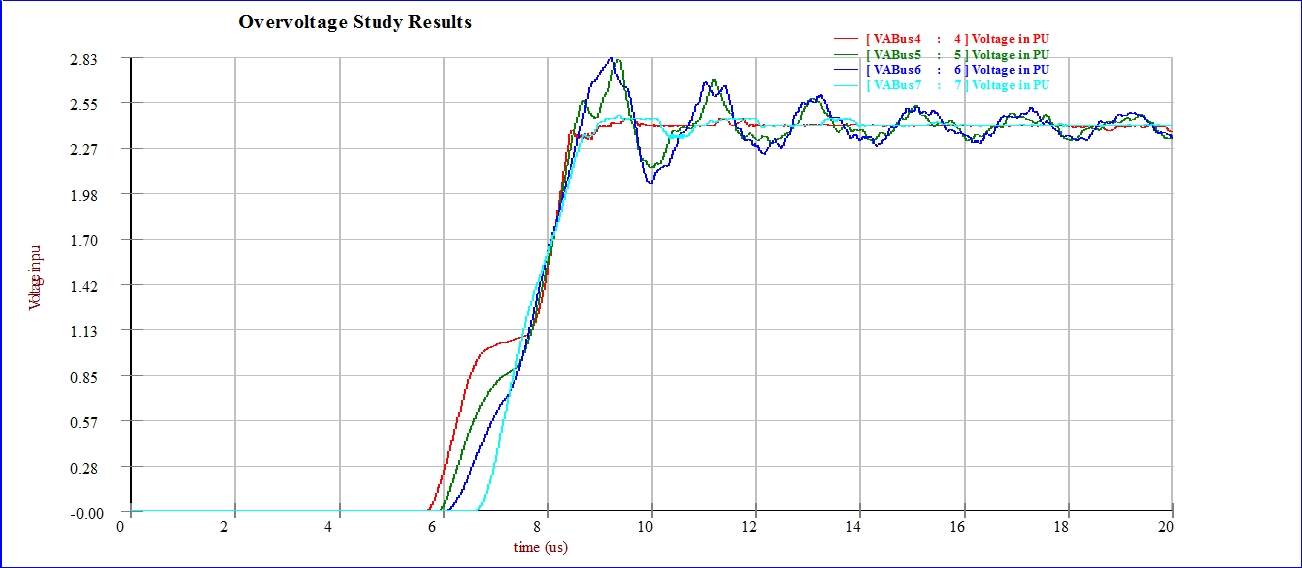
Phase-A voltages at different locations in substation during direct lighting stroke to overhead transmission line.
EMTP STUDIES
In addition to insulation co-ordination study, Electro-magnetic transient studies are also carried out for providing solutions on array of different applications and requirements. Amongst these, selection of circuit breaker by analysing the transient recovery voltage (TRV), rate of rise of recovery voltage (RRRV) and interruption capability of circuit breakers during switching operation of power system elements, overvoltage and induced voltage analysis to assess the transient voltages accruing with switching operations of the transmission systems, capacitive and reactive loads and dynamic-
overvoltage’s due to load rejection, fault condition etc., analysis of secondary arc current during single phase to ground fault and determination of rating of neutral grounding reactors for successful auto-reclose operation, analysis of arcing ground faults and mitigation techniques, analysis of failures of electrical equipment like circuit breaker, transformers etc. under transient operational conditions, study of possibilities of ferro-resonance in electrical system and mitigation solutions etc. are some of the areas addressed under electro-magnetic transient studies.
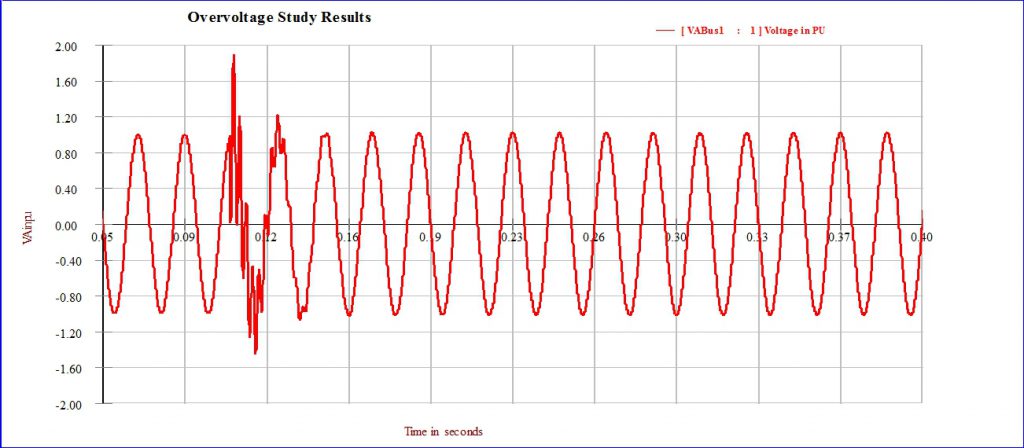
Phase-A voltage during shunt capacitor bank switching (peak bus voltage -1.88 p.u)
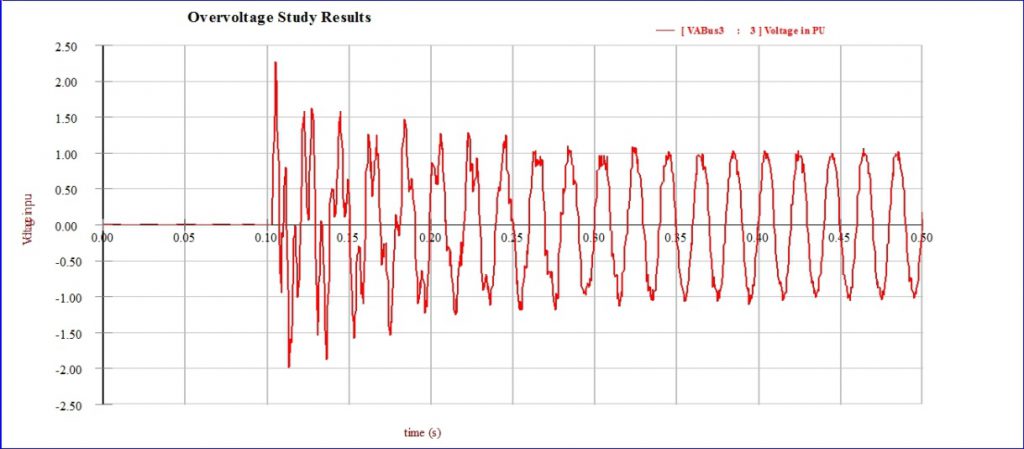
Phase-A voltage at receiving end bus during line energization
HARMONIC MEASUREMENTS
Harmonic measurements are carried out on industrial or commercial sites: to obtain an overall idea on distribution-network status, to determine the origin of a disturbance and determine the solutions required to eliminate it, to check the validity of a solution. The harmonic indicators can be measured by an expert present on the site for duration of from 1 hour to 1 week based on the type of measurements or in some cases the meters will be connected permanently installed in the distribution network, allowing a follow-up of Power Quality.
The results of measurement will help the analysis in order to: to determine any necessary de-rating of equipment in the installation or quantify any necessary harmonic protection and filtering systems to be installed in the distribution network or to check the compliance of the electrical installation with the applicable standards or Utility regulations (like IEEE and IEC standards).
Measurement devices provide instantaneous and average information concerning harmonics. Instantaneous values are used for analysis of disturbances linked to harmonics. Average values are used for Power Quality assessment. The results will be provided for: harmonic spectrum of currents and voltages (amplitudes and percentage of the fundamental), THD (Total Harmonic Distortion) for current and voltage, for specific analysis: the phase angle between harmonic voltage and current of the same order and the phase of the harmonics with respect to a common reference (e.g. the fundamental voltage).
The most significant harmonic orders in three-phase distribution networks are the odd orders (3, 5, 7, 9, 11, 13 ….). Triplen harmonics (order multiple of 3) are present only in three-phase, four-wire systems, when single phase loads are connected between phase and neutral. Utilities are mainly focusing on low harmonic orders (5, 7, 11, and 13). Harmonic amplitudes normally decrease as the frequency increases. Sufficiently accurate measurements are obtained by measuring harmonics up to order 50. PRDC® provides the service to know the harmonics for customers, utilities, solar PV and Wind farm owners.
HARMONIC MITIGATION
In simple terms, harmonics are extra frequencies that when present in an electrical circuit, distort the AC sine wave. The distorted current waveform created by non-linear loads can cause many problems in an electrical distribution system. The effects of harmonics include: Voltage distortion like Excessive temperature rise in motors, Electrical noises, Sensitive electronic equipment malfunction; Increase in the apparent power and over-sizing of sources, capacitors, cables which enable de-rating of electrical equipment or over-sizing, accelerated ageing of equipment; flow of current in the neutral conductor which causes excessive temperature rise in transformer and tripping of circuit breakers.
PRDC® provide services by measuring the harmonics and performing the harmonic analysis based on the type of the installation and system. Based on harmonic analysis the best possible harmonic mitigation solution will be provided. The harmonic mitigation solutions include: inductors, capacitors, passive harmonic filters and active harmonic filters, phase shifting transformers etc. PRDC® provides the design specifications for harmonic mitigation devices based system specific harmonic analysis.
VOLTAGE & FLICKER MEASUREMENTS
The voltage flicker is a result of varying nature of reactive power demand of loads. Due to the varying nature of reactive power demand, poor performance is observed in lighting and other voltage sensitive loads. Typical loads causing voltage flicker include fluctuating loads like Electric arc furnace, rolling mill loads etc. or starting of large induction or synchronous motor etc.
In case of violation of flicker limits, solution involving necessary reactive power support as close to the loads causing the flicker is to be suggested for preventing the rest of network experiencing from voltage flicker phenomenon.
We undertake flicker measurements followed by detailed transient simulation studies to arrive at various options including the type of compensation, size and location required to mitigate the voltage flicker in case of observed voltage flicker is exceeding the permissible limits as per stipulated standards.
PSS TUNING
Power system stabilizers (PSS) have been extensively used in power systems as a very effective means to provide damping control for electro-mechanical oscillations (from 0.1 Hz to 2 Hz). Successful application of power system stabilizers depends on the careful design of its functional structure and regular tuning of its parameters in order to accommodate the ever changing and evolving system characteristics and conditions. To provide effective damping and ensure the stability of the system, the PSS should be carefully tuned. The tuning process is a topic of big interest for excitation systems and PSS manufacturers, who should complete the commissioning of a controller with a suitable and robust tuning according to the specific generator where the PSS is added and to the different operating conditions of the system.
Two PSS tuning objectives are available to suit different applications :
- Tuning for individual generators. This focuses on tuning PSS for specified generators for damping improvement of all modes associated with the generators.
- Tuning for inter-area modes. This computes all inter-area modes in a specified frequency range and then identifies the generators that have best controllability to the critical modes. PSS will be tuned on these generators to achieve the best possible damping to the modes.
FAULT RIDE THROUGH COMPLIANCE OF RE
Large scale of wind power has been installed in everywhere around the world. Both the wind farm installation capability and the wind turbine capacity have increased rapidly. There are many constant speed wind turbines using stall control with squirrel cage induction generators installed in the wind farms. Newly installed wind turbines are dominated by variable-speed wind turbines using pitch control with doubly fed induction generators and direct-driven permanent-magnet synchronous generators.
Power system operation with increasing wind power penetration will become more and more difficult. More conventional power plants will be replaced by wind farms and accordingly the stability of the power system will be affected. So the new grid codes have proposed even strict requirement to the wind power. Not only the wind turbines should be kept connection in grid during the fault and fast recover power generation after fault clearance, but also the wind turbines or wind farm can provide the voltage support and generate capacitive reactive power.
SUB SYNCHRONOUS RESONANCE & MITIGATION
Subsynchronous resonance (SSR) is one of the power system dynamic phenomena and its occurrence is of interest in power system networks where series compensated transmission lines or HVDC transmission systems are in the vicinity of a turbine generator. In series compensated networks, resonance characteristics of the network may vary significantly based on the topology and short circuit levels of the system. The frequency range of Sub Synchronous Oscillations (SSO) varies from 10 Hz up to 50 Hz. It has been known that the system is expected to be more prone to SSR interactions for a radial configuration i.e. those contingencies which result in the turbine-generator feeding radially to the lines with the series capacitors. Hence, PRDC® performs the analysis for different network topologies/configurations by considering such combinations of contingency of network elements which tend to make the series compensated network radial with the Thermal generation.
Based on the kind of interaction between mechanical & electrical systems and on the kind of disturbances considered, SSR phenomenon manifests itself in following forms:
- Induction Generator (IG) Effect (Self-Excitation)
- Subsynchronous Torsional Interaction
- Transient Torques
PRDC® also provides the services to find the vulnerability of wind farms to Sub Synchronous Oscillations (SSO) due to nearby series capacitors and recommends the mitigation or protection solutions based on the network configuration.
The following electrical equipment’s are at more risk due to SSO :
- Electrically closer to series capacitors.
- Long shaft / multi-mass generators (Coal, NG Steam and Combined Cycle).
The state of smart grid deployment covers a broad array of electric system capabilities and services enabled through pervasive communications and information technology, with the objective to improve reliability, operating efficiency, resiliency to threats, and our impact to the environment.
Distributed energy resources : The ability to connect distributed generation, storage, and renewable resources is becoming more standardized and cost effective to the consumers as well for the utilities. Several other concepts associated with a smart grid are in a nascent phase of deployment and includes the integration of microgrids, electric vehicles, and demand response initiatives, including grid-sensitive appliances. For successful integration of these smart grid initiatives, it is important to analysis the grid integration issues with high penetration levels of renewable generation at distribution level, impact and analysis of EV’s and demand response programs. The issues in RE integration include how to manage the voltage rise at distribution system, how much renewable penetration (like solar PV generation) can be allowed to connect to grid, impact of harmonics due to added renewables, impact of demand management, impact of electrical vehicles etc.
Electricity infrastructure : The smart grid areas that fit within the traditional electricity utility business and policy model have a history of automation and advanced communication deployment to build upon. Advanced metering infrastructure is taking automated meter reading approaches to a new level, and is seen as a necessary step to enabling dynamic pricing and consumer participation mechanisms.
Though penetration of these systems is still low, the growth and attention by businesses and policymakers is strong. PRDC® provides the services required electricity infrastructure for enabling smart grid environment by performing system studies at transmission level and distribution level. PRDC® also provides the services for preparing DPRs for transmission and distribution substation automation and the requirement of information exchanged with control centers. DPR also consist of Cost/benefit thresholds which are now encouraging greater levels of automation at the distribution substation level. With the addition of smart grid technologies every utility want to the change in reliability of the supply. PRDC® provides the services for smart transmission system by analysing the requirement of optimal PMUs and FACTS devices for national level transmission network. At distribution end, PRDC® provides the reliability indices based on distribution system reliability analysis for both conventional distribution system and smart grid systems where renewables and smart grid technologies are integrated.
Business and policy : The business cases, financial resources, paths to deployment, and models for enabling governmental policy are only now emerging with experimentation. This is true of the regulated and non-regulated aspects of the electric system. PRDC® provides the state of art guidelines and regulations for smart grid operational procedures. Also provides the cost best analysis for installation of solar PV panels.
PRDC is a leading consulting firm in India with over a decade of experience in government-funded underground (UG) cabling projects. Our expertise spans the entire project lifecycle—from conceptualization to handover—across 17 projects with a combined value of approximately INR 2570 crore. PRDC specializes in UG cabling design for complex brownfield areas, offering services such as prefeasibility and feasibility studies, detailed design, technical specifications, tendering, EPC (Engineering, Procurement, and Construction) selection, and project management.
PROJECTS IN INDIA



INTERNATIONAL PROJECTS


As a Project Management Consultant (PMC), PRDC ensures projects meet IS and IEC standards, focusing on planning, quality, and safety during execution, as well as handling bill processing for EPC agencies. Additionally, PRDC operates as a Third-Party Independent Agency (TPIA) to witness Factory Acceptance Tests for various UG cabling equipment. The firm also integrates SCADA automation systems with UG cabling schemes.
PRDC’s ventures in underground (UG) cabling projects cover a wide array of services and project types. Our projects typically involve the following aspects:
- EHV, HV, and LT Cabling Projects: PRDC has completed 17 underground cabling projects involving Extra High Voltage (EHV), High Voltage (HV), and Low Tension (LT) systems. These projects are spread across different utilities with substantial project costs.
- Government-Funded Projects: PRDC’s primary focus is on government-funded underground cabling projects, aiding in urban infrastructure upgrades and reliable power distribution.
- Brownfield UG Cabling Projects: We specialize in brownfield projects, which involve retrofitting or upgrading existing infrastructures, a complex task due to space constraints and integration with existing facilities.
- End-to-End Project Services:
- Prefeasibility and Feasibility Studies: Conducting studies to determine the project’s viability and assess technical and financial requirements.
- Detailed Design and Technical Specifications: Designing UG cabling schemes and creating technical specifications for equipment.
- Tendering and Bidding Process: Preparing tender documents, managing the bidding process, and selecting Engineering, Procurement, and Construction (EPC) contractors.
- Project Management Consultancy (PMC): PRDC acts as a PMC, overseeing project planning, quality control, and safety compliance. This role includes processing bills to ensure smooth payment disbursement to EPC agencies.
- Third-Party Independent Agency (TPIA) Services: PRDC also provides third-party inspections, including Factory Acceptance Tests for critical equipment like UG cables (132kV, 33kV, 11kV, and LT), Compact Secondary Substations (CSS), Ring Main Units (RMU), Gas-Insulated Switchgear (GIS), and other essential components.
- SCADA Automation and Integration: We incorporate Supervisory Control and Data Acquisition (SCADA) systems within UG cabling designs, supporting automation and enhanced monitoring capabilities for utilities.
- Civil and Structural Design Services: Beyond electrical engineering, PRDC provides expertise in civil and structural engineering, such as designing foundations, RCC trenches, and buildings, ensuring structural stability and project durability.
The Strength of PRDC lies in its team of experts, many of whom have over 10 years of field experience in UG cabling. Our team includes domain experts in both electrical and structural engineering, supported by senior consultants with over 30 years of experience across multiple areas.
- Proven Track Record: Successful execution of high-value underground cabling projects across multiple utilities.
- Experienced Team: Our experts include seasoned engineers with over a decade of field experience in underground cabling design and implementation.
- Comprehensive Services: From feasibility studies to PMC (Project Management Consultant) and TPIA (Third-Party Independent Agency), we provide end-to-end solutions to ensure project success.
- Focus on Quality and Safety: Adherence to international standards, ensuring robust and reliable underground infrastructure.
PRDC’s excels in DPR preparation for the construction of 132/33kV GIS SS, 33/11kV GIS SS, 132kV UG Cabling, and 33kV/11kV/LT UG cabling in the field of detailed design engineering. PRDC delivers excellence in site setup and policy-driven strategy by utilizing sophisticated modelling tools in conjunction with quantitative and qualitative data analysis. PRDC supports clients accomplish in achieving high sustainability standards, optimizing project costs, and manage every phase of the development cycle efficiently.
Transform your power distribution network with PRDC’s cutting-edge underground cabling solutions. We are here to assist you in creating safer, more efficient, and resilient electrical systems that meet the demands of modern infrastructure.
PRDC stands as a trusted leader in the field of detailed engineering and project management consultancy (PMC) for Extra High Voltage (EHV) systems. Our extensive experience covers the entire lifecycle of EHV projects, from initial design to successful project execution and commissioning. We have delivered numerous projects that enhance the reliability and efficiency of power systems, offering innovative solutions tailored to client needs.
Comprehensive Substation Design Solutions
PRDC excels in substation design, covering all critical aspects for smooth project execution. Our team of expert engineers and consultants ensures the design of General Arrangement (GA) layouts that optimize spatial configuration for efficient operation and maintenance. We also specialize in GIS substation design, prioritizing space optimization, reliability, and safety.
Technical Specifications and Detailed Engineering
PRDC meticulously prepares technical specifications for plant and equipment, ensuring all components meets stringent quality standards. By defining precise specifications, we help clients achieve system integration while adhering to industry best practices.Our detailed engineering services encompass:
- Bill of Quantities (BOQ) preparation to outline the required materials and equipment.
- Cost estimation to ensure budget accuracy and financial feasibility.
- Comprehensive civil and structural design to support robust infrastructure, including foundations, control buildings, and cable trenches.
Project Management Consultancy (PMC) for EHV Systems
PRDC’s PMC services are tailored to oversee the entire project lifecycle, ensuring timely completion within budget. Our expertise includes:
- End-to-end project management, from developing technical specification to vendor selection and procurement.
- Supervision of civil works, ensuring compliance with design specifications and safety standards.
- Continuous monitoring and reporting throughout the execution phase to ensure quality control and risk mitigation.
With a proven track record in delivering successful EHV substation projects, PRDC combines industry-leading engineering practices with hands-on project management. Our commitment to excellence and attention to detail ensures that every aspect of the project, from substation design to the civil and structural design of supporting infrastructure, meet the highest standards of safety, reliability, and efficiency.
Partner with PRDC for your next EHV project and leverage our extensive experience in GIS substation design, technical specification preparation, and comprehensive project management consultancy services. We are committed to helping you build resilient power systems with a focus on cost-effectiveness and long-term sustainability.
At PRDC, we bring decades of industry expertise to deliver comprehensive network survey and data repository services. As a leader in power system consulting, we understand that reliable data is the cornerstone of effective decision-making and system optimization. Our solutions enable utilities, industrial clients, and infrastructure developers to gain deep insights into their networks, supporting efficient planning, operations, and maintenance.
Comprehensive Network Survey Services
PRDC offers end-to-end network survey solutions that cover both new and existing power systems. Our team of highly skilled engineers and field specialists uses cutting-edge technologies to conduct detailed assessments of electrical infrastructure, ensuring data accuracy and completeness. Our network surveys include:- Geospatial Mapping: Using advanced GPS and GIS tools to accurately map overhead and underground assets.
- Asset Identification and Condition Assessment: Evaluating the current state of substations, transformers, feeders, and other critical components.
- Load Data Collection: Gathering real-time data on power consumption patterns to optimize network performance.
Building a Robust Data Repository
PRDC offers specialized services to develop a centralized data repository, ensuring that all network information is securely stored, easily accessible, and ready for analysis. This repository serves as a powerful tool for utilities and industries, enabling efficient asset management and proactive maintenance. Our data repository solutions include:- Database Design and Integration: Developing custom databases to consolidate survey data, drawings, and equipment specifications.
- Digital Data Storage: Converting physical records into digital formats to streamline data access and retrieval.
- Real-Time Data Analytics: Implementing analytics platforms that provide actionable insights for optimizing network operations.
- Data Security and Compliance: Ensuring that all data storage systems comply with industry standards for data privacy and cyber security.
Benefits of PRDC’s Network Survey and Data Repository Services
- Improved Network Efficiency: Comprehensive surveys and data repositories enable utilities to enhance network performance and reduce energy losses.
- Enhanced Asset Management: A well-maintained data repository helps in effective asset management, reducing the risk of unexpected failures.
- Cost Optimization: Accurate data collection and analysis lead to better planning, minimizing operational costs and optimizing resource allocation.
- Future-Ready Infrastructure: By digitizing network data, we prepare utilities for smart grid integration and future technology advancements.
With our extensive experience in network surveys and data management, PRDC is your trusted partner for building resilient, efficient, and future-ready power systems. Our proven methodologies, advanced tools, and industry expertise ensure that your network data is not only accurate but also actionable, helping you achieve your operational goals with confidence.
Let PRDC support your journey to modernize your network with precise surveys, comprehensive data repositories, and cutting-edge analytics solutions. Empower your infrastructure with data-driven insights and achieve greater efficiency and reliability in your power systems.
